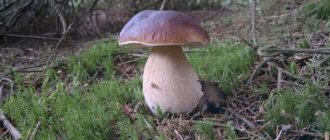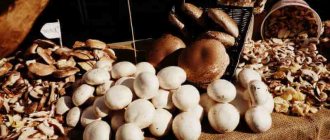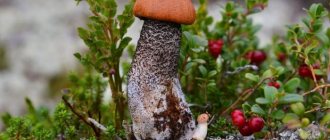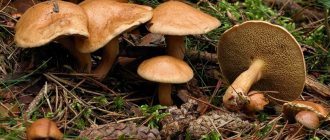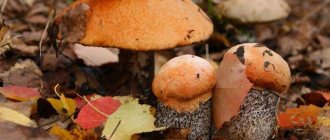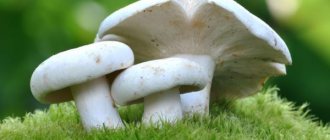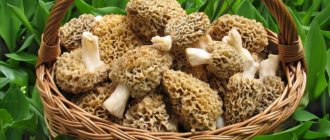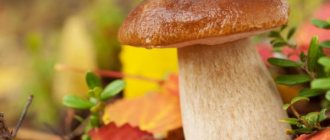Seasonal characteristics of mushroom growth
Fungi are complex organisms. Their main part - the mycelium or mycelium - is hidden from view by a layer of forest humus, and only fruiting bodies appear on the surface, which attract mushroom pickers. Mycelium grows all year round, so it is not easy to answer the question at what temperature mushrooms grow in autumn.
Along with humidity, one of the most important conditions for fruiting for most species is warm soil. Therefore, the first mushrooms appear in the spring. In April-May, when clearings, clearings and forest burnt areas freed from snow warm up, morels and stitches appear. They are the ones who open the mushroom season, and then other mushrooms pick up the baton.
Towards the end of May and early June, after warm rains, the first moss mushrooms, boletus mushrooms, and even white ones appear. But these are only scouts; the main layer will appear later, when the rye begins to sprout. By the way, these mushrooms are popularly called spike mushrooms.
Aspen boletuses, or as they are also called, krasoviki, redheads, appear a little later, when the aspen has faded. At the same time, colorful caps of russula peek out from the grass, and cheerful flocks of chanterelles scatter in the moss, like orange beads.
But the summer layers are short - a week, two at best, and the mushrooms disappear as if they never existed. But the real mushroom will only grow in the fall, when the braids of the birches begin to turn golden and splash crimson on the foliage of the aspens.
Types of boletus in October
There are about 18 varieties of boletus in nature. They all bear fruit in the fall. Some of them are extremely rare and are found only in a limited area. A description of the most common specimens should be considered.
Spruce
The spruce boletus is found mainly in old spruce and mixed forests. His hat is chestnut brown. In young specimens it has a hemispherical shape, and in old specimens it is straight. The surface of the cap is velvety, slightly wrinkled.
Note! At first, the plates of the mushroom are white, but then they acquire a yellow or greenish tint.
The stem is beige in color, thicker at the root. Its height ranges from 6 to 20 cm. The thickness of the leg ranges from 2 to 5 cm. The largest specimens reach 2 kg. The pulp is white, with an intense smell and taste. The mushroom begins to bear fruit in early June and ends in October. The bodies appear both singly and in rings. Overripe large specimens are not harvested; they are left for animals. Animals eat them, spreading the spores.
Oak
This boletus often enters into symbiosis with old oak trees. Fruiting bodies often form near the roots of large trees. The hat is coffee-gray with minor light inclusions. Its diameter is 5-20 cm. With age, it becomes wrinkled.
With high humidity, mucus appears on the surface. The plates are white, but may turn yellow as they age. The flesh of a young mushroom will be dense but brittle. The height of the leg is 3-20 cm. Its color is milky or beige. Appears in large groups from early June to October.
Birch
The birch boletus has a light yellow cap with a slight pinkish tint. Its diameter is 5-15 cm. In humid weather, mucus appears on the surface. The pulp is white, but with prolonged contact with oxygen it can quickly darken and does not have an intense mushroom smell. The plates of young specimens are milky in color, but may turn yellow over time. The leg is dense, barrel-shaped. It is distinguished by its light brown color. The tubular layer is yellow.
Note! This type of boletus forms mycorrhiza mainly with birch trees, so fruiting bodies can often be found under old trees.
Found both singly and in large groups. Begins to bear fruit in mid-summer. The peak is in September and October. When the harvest season begins depends on weather conditions.
Pine
The cap of this boletus species is dark brown in color with a slight reddish-violet tint. The edging is lighter. The diameter of the cap is 8-25 cm.
The pulp is highly dense and pale pink. It has a rich taste and aroma. The leg is thick, reaches 15 cm in height. Its surface is lighter in color than the cap. The thickness of the tubular layer is approximately 2 cm.
The first specimens appear in the spring. Fruits until the end of September. Rarely seen in October. The pine white mushroom has a lighter shade of the cap. This variety prefers sandy soils. It forms mycorrhizae with old pine trees.
Other
There are a number of varieties of boletus that are less common. These include:
- royal;
- reticulate;
- semi-white;
- dark bronze, etc.
Royal porcini mushrooms have a large pink or red cap. Its diameter is 8-22 cm. The thick barrel-shaped leg has a rich yellow tint, reaches 15 cm in height and 5-15 cm in diameter. It is covered with a smooth peel. In older specimens, the surface is cracking. The pulp is milky in color, but upon contact with oxygen it acquires a blue-violet hue.
Important! King boletus loves limestone and sandy soils. More often it forms mycorrhiza with deciduous trees.
This variety has a rich taste and aroma. It is suitable for any heat treatment, drying and preservation. Can be consumed raw. Attempts are now being made to grow this variety under artificial conditions.
The net boletus has a light yellow cap. Its diameter reaches 30 cm. In young specimens it is smooth, and in old specimens it is covered with a network of small cracks. The pulp is dense, white and fleshy. The length of the leg reaches 3-12 cm. It has a club-shaped shape, a beige surface with a pronounced retina. When broken, the mushroom emits a pleasant aroma. The fruiting bodies of this species are found in the steppe zone near rare trees or shrubs.
The semi-white boletus has a smooth, hemispherical cap. Its diameter reaches 15 cm. The pulp is dense, with a sweetish taste. The stalk is thick, but its length rarely exceeds 15 cm. The tubular layer reaches 2.5 cm. This mushroom is found mainly in deciduous and mixed forests, incl. in the Leningrad region.
The dark bronze boletus has a dense, convex cap, reaching 7-17 cm in diameter. It is covered with smooth, rich brown skin. The pulp is white, but darkens slightly when broken. The leg is cylindrical, gray-pink in color with dark brown spots. This species grows in deciduous forests in warm regions. Peak fruiting occurs in mid-autumn. The mushroom is rare, so attempts are being made to grow it under artificial conditions.
Mushrooms of the autumn forest
In autumn, almost all types of summer mushrooms grow, but new ones also appear, those for which it is too hot in summer. These are, for example, autumn honey fungus, greenfinch, row and others. Moreover, in autumn the growth of mushrooms is most intense, since they do not like heat, and in order for the fruiting body of most species to begin to develop, 5–10 ° C is enough. The temperature at which mushrooms grow in the fall affects the speed of their development: the lower the degree, the slower they grow.
However, not only temperature indicators matter, but also humidity. If autumn is dry, then you can’t count on a good “catch” of mushrooms. However, they don’t like prolonged rains either. An experienced mushroom picker will look at how the next bad weather splashes on the roads in puddles, and sigh sadly: “Eh, the mycelium will get wet!” The mycelium, of course, will not get wet, it will remain under the dense forest floor of fallen pine needles and moss, but there may indeed be no mushrooms.
But light frosts, which are not uncommon in autumn, are not scary for mushrooms. Sometimes on a cold October morning in the forest you can find boletus, boletus, redhead, boletus, and honey mushrooms literally frozen through. When determining at what temperature mushrooms grow in the forest in the fall, you should focus on average daily values, since warming up the soil during the day plays an important role.
False boletus
General distinctive features of boletus
The variety of this group of mushrooms is the safest. However, when picking, inexperienced mushroom pickers often have doubts about how not to make a mistake and bring home a false mushroom.
Regardless of the type of boletus, its leg has the shape of a cylinder, but only in young individuals. With growth, the leg increases, and the cap, on the contrary, stops growing. It seems that the mushroom is of a disproportionate, disturbed shape. In very mature mushrooms, the cap grows and reaches 20 cm in diameter. It is pleasant to the touch - velvety and dry. On the inside of the cap there is a tubular layer. Depending on ripeness, they have a white or grayish tint, which turns black when pressed.
The leg is velvety and slightly rough to the touch. Its distinctive feature is the presence of scales. They form as the fungus grows. In a damaged area, the real boletus shows metamorphosis: first it turns blue, then acquires a black color. This is the main distinguishing feature.
Doubles
Gall mushroom (gorchak)
In places favored by boletuses, you can find false mushrooms that are very similar to them. The most common lookalike is gall fungus (gorchak) . You won’t find it in deciduous forests; it grows only in coniferous forests. A favorite place is under the spruce and pine trees. In order not to be deceived, you need to pay attention to the distinctive features.
If, after checking, this mushroom ends up on the table, then there is no need to panic. It does not contain poisons, but the name speaks for itself. The mushroom has a very bitter taste and if it gets mixed with the rest, it will spoil the dish when fried. It is impossible to eat, it resembles the bitterness of bile.
Despite the fact that there are no poisons in this mushroom, it is still undesirable to taste it; the bitterness is converted into toxins, settles in the liver and can cause severe intoxication in the body. The principle when picking mushrooms is – if you don’t know, don’t take it.
There are no false boletuses in nature. There is only a double - bitterling . They can't get poisoned. Therefore, even inexperienced people collect these mushrooms; it is quite difficult to confuse them with others.
When the frost hits
Few of these forest dwellers can survive severe frost, and most mushroom pickers believe that the season ends in November. But that's not true.
One of the most cold-resistant mushrooms is honey mushrooms. The best temperature for their growth varies in the range of +8 ... +12 oC. Their cheerful families grow in the forest even after serious frosts. At what temperature do mushrooms grow in autumn? Winter honey mushrooms, for example, can be found at sub-zero temperatures, even under snow.
Winter oyster mushrooms are also not afraid of frost, which can be harvested not only in November, but also in January.
At what temperature do mushrooms stop growing?
You may be interested in: How do edible talkers differ from false mushrooms? How many days after rain do mushrooms grow? Bitter mushroom: photo and detailed description
Every experienced mushroom picker knows that the most delicious and popular mushrooms appear in the forest at the end of summer and continue to delight until late autumn. The most active growth of fruiting bodies occurs at the end of August, when the air temperature is 18-25°C.
With the onset of autumn, it gradually gets colder outside, and most species stop growing already at 15°C. However, some specimens are able to develop normally at lower temperatures. Sometimes new mushrooms appear under fallen leaves even on very cold days, when the thermometer does not exceed 5°C.
During frosts, all types of mushrooms stop growing. Most of them simply freeze and continue to grow after the thaw. Therefore, in warm winters you can find honey mushrooms or oyster mushrooms in the forest.
It is worth noting that during the cold season, only the fruiting bodies visible above the ground stop growing. But the mycelium, hidden under a layer of soil and foliage, grows and develops all year round. It can only be damaged if the winter is very cold and the soil is very frozen.
The most optimal temperature for the active growth of most types of mushrooms is considered to be 18-25°C. However, some species thrive at lower temperatures. And everyone’s favorite oyster mushrooms and honey mushrooms can grow even in winter, provided there are frequent thaws.
Conditions for the growth of porcini mushrooms
No matter how full the mushroom picker’s basket is, his luck is judged primarily by the number of porcini mushrooms.
White, or, as it is also called, boletus, is a cunning and finicky mushroom. Sometimes you have to go around half the forest to attack a mushroom place. But if the conditions are suitable, then even in a small patch you can collect more than a dozen strong boletus.
At what temperature do porcini mushrooms grow in the fall? Firstly, we note that for white it is not so much the condition of the air that is important as the condition of the soil. The optimal soil temperature for it is 15–16 degrees Celsius.
But as for the air, the conditions for the growth of porcini mushrooms in summer and autumn are different. In summer, boletus mushrooms do not like excessive dampness and prolonged rains and prefer temperatures of +18 ... +20 oC. That's why they hide in the moss and under the thick paws of spruce trees, where it is not very hot.
But already in the second half of September the weather in central Russia is rarely warm. At what temperature do mushrooms grow in autumn? Starting from September, the optimal regime for the growth of porcini mushrooms will be 10–15 degrees Celsius. Moreover, night frosts do not bother them at all. The main thing is that the air and soil warm up during the day.
The best time to collect different types of mushrooms is in summer and autumn
The first mushrooms appear in April, but May is considered the official opening month of the mushroom season. Usually mushroom hunting lasts until October inclusive. But if weather conditions are favorable, new mushrooms grow in November and even in December.
It is better to harvest according to the mushroom calendar. Based on his data, the mushroom picker is less likely to run into an inedible double. The following table details the entire growth period of certain edible species.
When to collect boletus mushrooms in the fall
Boletus mushrooms, especially young and strong ones, are in no way inferior to white ones - even boiled, dried, or fried. And if they go in layers, then you can collect more than one bucket of them in a relatively small forest.
According to popular belief, the first boletuses appear when the mountain ash blooms, and then they do not leave forest glades and birch groves all summer. Unless, of course, the summer was too hot and dry. But the summer boletus has one drawback - the worm really loves this tasty mushroom. So the mushroom picker has to reluctantly throw away one mushroom after another.
In autumn, boletus flowers are clean and strong. And besides, their special appearance appears - with a thick stem and a dark cap, the taste is practically no different from the white one. Finding it, however, is not easy in the fallen leaves. But if you come across one, then you can find a dozen more around it.
At what temperature do mushrooms grow in autumn (boletus mushrooms)? Their temperature regime is almost the same as that of whites. For boletus, 10–12 degrees Celsius is quite enough, only these mushrooms love wetter weather, not prolonged rains, but thick autumn fogs. And if the autumn is dry, then boletus mushrooms should be looked for in damp places, in lowlands and even in a swamp.
A good mushroom picker knows at what temperature mushrooms grow. In the fall, in the forest, he will quickly fill a basket, or even take out a bag - don’t leave boletus and boletus, aspen and boletus, milk mushrooms and capillaries under the fir trees and birches! And if honey mushrooms attack, there may not be enough packages.
How to collect correctly
Anyone who has ever gone to the forest to pick mushrooms knows the basic rules for picking:
- The mushroom trophy cannot be pulled out of the ground along with the roots.
- When going out on a “quiet hunt,” you should stock up on a small, sharp knife, with which you cut off the prey above the soil surface. Thus, the mycelium is preserved and grows, and next year you can count on a generous harvest of whites in the same place.
- Before going into the forest, you should stock up on a long stick or staff to carefully dig out mounds of leaves, moss and earth, under which strong families are hiding.
Autumn is a great time to visit a quiet, colorful forest, filled with the smell of mushrooms and fallen leaves. And what could be better than a basket of strong boletus, brought from a walk and filling everything around with a mushroom aroma.
People very often encounter mushrooms in everyday life, without even suspecting that they are dealing with them. We are accustomed to thinking that mushrooms are gifts of nature growing in the forest. However, mushrooms also include yeast, which every housewife uses to prepare dough. Fresh yeast has good lifting force, the dough rises quickly and well, the baked goods are fluffy, finely porous, and appetizing. Bad, “weak” yeast produces products of poorer quality. Or, for example, the bread in your bread bin became moldy and, in general, you began to notice that the bread in this bread bin was quickly becoming moldy. An experienced housewife knows what's going on here. You need to thoroughly rinse, wipe and dry the bread bin - the molding of the bread will stop. Here we also encounter mushrooms. Mold, that is, the proliferation of fungi, depends on a number of factors: temperature, relative air humidity, and the presence of oxygen.
Thus, mushrooms in the first and second cases are living beings capable of living and reproducing. What do yeast and mold have in common with wild mushrooms, which we collect and store for future use? They are united by common structural features. If we examine a piece of mold under a microscope, we will see mycelium, or mycelium, which in appearance resembles spider web felt. This is actually the mushroom itself, its body. Webs are thin threads called hyphae that grow only at their tips. A fungal cell differs from other plant cells not only in shape and content. Its shell consists of a special substance - fungin, which gives the cell special strength and is destroyed only by prolonged exposure to high temperature. This explains the need for longer heat treatment of mushrooms when preparing dishes. For the same reason, it is not recommended to consume mushrooms for people suffering from gastrointestinal diseases. The peculiarity of mushrooms is that instead of the starch inherent in plants, they contain glycogen - starch, which is present only in animal organisms. It is no coincidence that the ancients classified mushrooms as objects of animal origin. Mushrooms do not contain chlorophyll and are not able to synthesize organic substances, although, like all living organisms, they need them. Therefore, mushrooms settle in any environment where the necessary nutrients are available. Reproduction can occur by spores and pieces of mycelium if placed in favorable conditions. How does a mushroom work? The fruiting body of the fungus, like the mycelium, consists of fungal threads - hyphae - which, depending on their belonging to one or another part of the fungus, perform strictly defined functions. For example, the integumentary hyphae covering the cap produce coloring substances from the outside, giving it a certain color. Other hyphae act as transporters—through them, water and various nutrients enter the fruiting body from the soil.
These hyphae are arranged vertically and fit tightly to each other, forming the mushroom stalk. The stalk carries nutrients to the cap, on which spores mature as they grow. The lower part of the cap of various mushrooms can be tubular (boletus, aspen boletus, boletus, boletus), consisting of many tubes fused together. The spores of these fungi are formed inside the tubes. Mushrooms such as saffron milk mushrooms, mushrooms, and champignons form plates on the lower part of the cap, which is why they are called lamellar. Spores of agaric fungi are found on both sides of the plates. Eats groups of marsupial mushrooms (morels, strings, truffles), in which spores are formed in the recesses of the winding cap; in puffballs, spores form inside the fruiting body. As the mushroom grows, the spores mature and fall out of the caps. The ripe spores of the raincoat are especially clearly visible; during this period they are called “puffers”. If you step on such a raincoat, it seems to explode, forming a column of dark dust. This dust is the spores of the puffball. The top of the mushroom cap is covered with a thin skin, which plays a protective role, protecting the fruiting body from adverse effects and moisture evaporation. It is not difficult to see the mycelium if you dig up the mushroom and carefully wash the lower part of the stem from the soil. You will see a delicate white cobweb - this will be part of the mycelium. In general, under favorable conditions, the mycelium grows very strongly, as if penetrating the ground with a web. A well-developed mycelium absorbs more nutrients from the soil necessary for the development and growth of the fungus. However, the mycelium not only consumes, but also helps create and absorb nutrients. Fungal mycelium secretes so-called enzymes that decompose the soil substrate and assimilate the products of its decomposition. Thus, the fungus lives and develops at the expense of the mycelium. The mycelium of all forest mushrooms is perennial, not at all picky about changes in external conditions, and tolerates frost and drought well. Therefore, mushroom pickers know “their” places where milk mushrooms, porcini mushrooms or boletus mushrooms grow. It seems that there are no signs of the appearance of mushrooms, but a favorable time comes, and the mycelium comes to life, bringing large harvests. Indispensable conditions, in addition to temperature, are relative air humidity and the presence of moisture in the soil. Fogs are especially favorable for mushroom growth. If fogs begin in the summer, it means it’s mushroom time. Mushroom pickers should know about another important condition for good harvests. As we have already said, the same mushrooms can grow in one place for several years and the number of mushrooms depends on its intactness. Some mushroom pickers do not comply with this condition and pull out the mushrooms “by the roots,” thereby causing great damage to the future harvest. Those who know always go for mushrooms with a knife, cutting off the stem carefully so as not to damage the mycelium. Next year they will definitely find a lot of mushrooms in the old places. This explains the “secret” of mushroom places.
Another indispensable condition is the proximity of mushrooms to certain types of trees. Only on a certain tree is a mushroom capable of forming a fruiting body: porcini mushrooms can be found in the vicinity of pine, spruce, oak, and birch; boletus - with aspen, boletus - with birch; saffron milk - with pine or spruce. This is where the names of many mushrooms come from. This kind of cohabitation was first noticed and explained by Russian scientists at the end of the 19th century. The fact is that mushroom hyphae and thin tree roots bring mutual benefit to each other. Trees supply mushrooms with carbohydrates, which mushrooms themselves cannot synthesize due to the lack of chlorophyll. But the mushroom does not remain in debt. Thanks to the highly branched mycelium, it supplies the tree with water, nitrogen and other nutrients, which it takes from plant residues decomposing in the soil. It has long been noted that young trees grow better if there are myceliums nearby that can bear fruit. The beginning, duration and end of mushroom growth depend on their type, as well as on weather conditions, not only of the current year, but also of previous years. Mushrooms usually grow in layers. It is believed that the first layer appears in mid-May, the second in the third decade of July, and the third, the longest, lasts from mid-August to October-November. Since the timing of fruiting is influenced by many factors, the harvest calendar can only be approximate. In recent years, mushroom yields have decreased significantly. The main reason is our mismanagement of forest products. Many do not know basic cultural gathering skills. On Saturdays and Sundays, you can see dozens of cars and motorcycles on the edges of the forest; some “virtuosos” manage to drive their vehicles into the thicket, disfiguring bushes and vegetation, and causing damage to the forest. Others search for mushrooms and turn over the litter, but this is the place where the fruiting body is born. There are different recommendations for collecting mushrooms. Some argue that mushrooms should be cut with a knife, others recommend carefully unscrewing the stem from the mycelium. Both methods can be considered correct. The main thing is not to damage the mycelium. It doesn’t occur to anyone to pick the berries along with the branches, but few people think that if you disturb, trample the mycelium, there will be no harvest. Mushrooms are a food product in the creation of which only nature takes part. There is evidence that before the First World War, the amount earned by peasants for wild mushrooms exceeded the cost of all the wood then exported abroad. Economists have calculated that collecting an average of 35 kg of mushrooms from 1 hectare of forest mushroom-bearing area gives a greater economic effect than growing wood on this hellish area. In the book by D. A. Telishevsky “Integrated use of non-timber forest products,” intended for forestry engineers and technicians, the factors influencing the collection and fruiting of mushrooms are systematized. It turns out that the yield of mushrooms depends on the age and completeness of the plantings. If the forest is old and dense, it is useless to look for mushrooms there. Young forests are most productive. They still have a thin layer of forest litter, which does not prevent the soil from warming up quickly, so here mushrooms appear much earlier and the harvest is greater. In the dark, dense forests, over decades, a thick forest floor has formed, which prevents the warm rays of the sun from warming the ground. In old forests, mushrooms can grow only at the edge. Over time, cleared areas become mushroom grounds. Already in the second or third year after cutting down coniferous and deciduous plantations, you can go looking for honey mushrooms. Thinning the forest is necessary for its improvement, as the access to light, heat and moisture increases, which also contributes to better growth of mushrooms. When mature forests are cut down at one time, after 2 years, morels and late honey mushrooms appear in the cleared area in early spring. Much later, after 5...6 years, when young shoots form and a young forest begins to form, nature gives boletus, boletus and boletus. Experienced mushroom pickers know that the largest families grow in thickets of young growth, as well as in places where forest residues are burned - fire pits. During the evolution of forests, groups of mushrooms are also replaced. After 8...12 years, when the tree crowns grow, boletus, boletus, russula, milk mushrooms and porcini mushrooms begin to appear in the forest. It is well known that with a warm spring and abundant rainfall, you can expect an abundance of mushrooms. However, each mycelium bears fruit only once per season. Why, then, in the same places during the summer, with periodic warm, heavy rains, do mushrooms appear again and again, as if in layers? It turns out that mycelium can be located at different depths. Under favorable conditions, the upper myceliums bear fruit first, then the myceliums located below, and so on. Thus, warm rains, especially in July-August, are of main importance for mushroom yields. Cool September rains do not cause mushroom growth. There are times when there is little warm rain, but the mushroom harvest is large. This can be explained by the fact that previous years were poor harvests. Each type of mushroom is favored by certain weather conditions. This explains the different fruiting times. It has been established, for example, that the white mushroom grows abundantly at an average monthly air temperature of 18°C and with sufficient rainfall. It is recommended to take this fact into account when artificially growing porcini mushrooms. The yield of mushrooms is affected not only by the weather of the current summer, but also of the previous autumn. A warm autumn with heavy rains is the key to a good harvest next year. People often say: “it grows like a mushroom.” Indeed, it is difficult to imagine a plant that would grow so quickly. However, the growth rate depends on many factors. Worminess greatly retards the growth of fungi. Dry weather also inhibits growth. Mushrooms grow evenly, regardless of the time of day. The greatest growth occurs after heavy rain. Tubular mushrooms grow and age faster than lamellar mushrooms. In late autumn, with the onset of morning frosts, mushrooms can grow for more than a month and age for the same amount of time. Therefore, in fruitful years, you can go for honey mushrooms until the first snow. They will always remain fresh, elastic, healthy. The entire fruiting period is divided into 3 stages or layers. The first layer occurs in the second half of May - early June, when haymaking begins, which is why the mushrooms are called hay-mows. The first boletus, boletus, boletus, and porcini mushrooms appear. But there are very few of them; as a rule, you need to look for them in well-lit places, abandoned forest roads, that is, where moisture has remained since spring and the soil has warmed up sufficiently. The first layer of mushrooms is short-lived - 7...10 days, so there is no need to hope for a rich harvest. In addition, the mushrooms of the first layer are often wormy.
The second layer begins in mid-July and lasts 2-3 weeks. The yield of the second layer is also small. Mushrooms are also found in well-lit clearings and on the edges of forests. Since the second layer of mushrooms coincides with the harvesting of winter grains, they are popularly called winter mushrooms. These mushrooms, like the First Layer mushrooms, are often damaged by worms. The third layer of mushrooms is the most productive and lasting. It starts in mid-August and lasts until October 0. During this period, the rains are usually even and cool, so the soil retains moisture at the same level. This is the most favorable time for mushroom growth, so experienced mushroom pickers go to the forest during this period. The third layer of mushrooms appears not only in clearings; they can be found in young forests and plantings. Mushrooms of the third layer are clean, dense, they are used for drying, salting, and pickling. There are phenomena that signal the appearance of mushrooms. In science they are referred to as phenosignalizers. The beginning of each layer is associated with the seasonal development of trees and shrubs. The first layer of mushrooms begins with the flowering of rowan; the second - with the flowering of fireweed; the third - with the first yellowing of birch leaves. Here are some signals of the appearance of individual species. The aspen blossomed and the male catkins began to fall off the tree - which means that the first morels appeared in the forest. The same aspen, when fluff flies from it, can serve as a signal for the appearance of the first aspen boletuses. Winter rye has ripened and the first porcini mushrooms appear. The mountain ash has bloomed - after 5...6 days you can look for boletus mushrooms. The pine tree began to bloom—grainy boletus appeared in the young pine forests. Severely yellowed birch trees indicate the beginning of honey mushroom growth. Mushrooms of different types themselves can be signaling agents: the abundant growth of fly agaric mushrooms coincides with the growth of porcini mushrooms; rashes have appeared, which means that saffron milk caps will appear in a few days. It is impossible not to mention the relationship between the fruiting period of mushrooms and their worminess. It’s a shame when there are a lot of mushrooms, the appearance is quite benign, but if you cut them in half, they are all riddled with tubules from worms. Many people have seen mushrooms cut in half and thrown away in the forest. What does this mean? The period of fruiting of the first or second layer of mushrooms is ending. In this place, it is almost useless to look for healthy, strong mushrooms. You may still find mushrooms, but most of them are old or wormy. The most benign mushrooms appear at the beginning of fruiting. The layer of mushrooms ages over time and becomes infected with insect larvae, so even young mushrooms at the end of fruiting are immediately damaged by worms. There are few mushrooms that are completely undamaged by worms, therefore, in industrial harvesting, specimens that are less than half damaged by worms are classified as benign mushrooms. It should be remembered that old wormy mushrooms can cause poisoning. And fresh mushrooms, even in the refrigerator, can be stored for a very short time (within a day), because they quickly deteriorate and are contaminated with microorganisms that cause poisoning. The literature provides data on the average worminess of mushrooms in the total mass during harvesting. Thus, chanterelles are not affected by worms at all, 5% of the harvested harvest is affected by honey mushrooms, 18.5% by porcini mushrooms, 25.6% by aspen mushrooms, 31.5% by boletus mushrooms, 38.2% by buttercups. However, when collecting mushrooms for personal purposes, wormy mushrooms should not be collected. It is necessary to adhere to the rule “less is more.” The resources of some types of mushrooms are being depleted. Unfortunately, in our country almost no work is being done to rationally exploit mushroom resources and increase their productivity. Experts believe that it is possible to preserve and increase the supply of valuable mushrooms by creating numerous micro-reserves in which mushroom picking will be prohibited.
Stages of fungal development
Mushroom growth does not depend on the time of day. When water enters the soil, it promotes the active growth of mycelium. This process can last several hours or days, after which the stem and cap begin to grow. It takes about 10 days for complete ripening (after this time the top of the cap can be seen on the surface). But not every rain promotes the rapid growth of fungal organisms. Short-term precipitation cannot sufficiently moisten the soil. When the soil is very dry due to a long absence of rain, it is not able to actively absorb moisture. For active growth, water must flow gradually, covering all layers of the soil.
Optimal conditions
In order for future mushrooms to develop intensively in the mycelium and grow quickly, the fungal organism requires certain conditions.
Temperature
The low temperature regime has a negative effect on young mycelium, and sudden spring frosts are detrimental to developing mushrooms. Cold weather with sudden temperature changes can greatly slow down and even completely stop the growth of the fruiting body. Intensive and accelerated ripening of mushrooms begins at temperatures from 18℃ to 30℃, but only with sufficient humidity, at least 60%.
Humidity
The humidity level should be about 60-70%, both in the air and in the soil. If the soil is not moist enough, the mushrooms stop actively growing, although the development of the fruiting body does not stop completely.
Irina Selyutina (Biologist):
The development of fungi is especially active when the soil moisture is 80-85%. However, if the substrate humidity reaches 95-100%, growth and development will begin to be delayed due to a lack of oxygen, which fungi, like all living organisms, need for their development. Thus, swampy soils contain only traces of free oxygen (O2) and due to this state of affairs, only species adapted to such unfavorable conditions can be found in them - emericellopsis, some fusariums, etc. The “killer” combination has a particularly unfavorable effect on the development of fungi - high humidity and low temperature. Therefore, harvesting a good harvest in a cold, rainy summer is just as unrealistic as a hot but dry summer.
Soil acidity (pH) is also very important for mushrooms - the active acidity of the environment, the value of which shows us the concentration of hydrogen ions (H+) in the environment. The normal life of the fungus and its vital processes, such as, for example, enzyme activity, spore formation, the entry of nutrients into the cell, and the synthesis of antibiotics and pigments, depend on it. Most mushrooms prefer acidic soils, while a smaller number prefer alkaline soils.
Pests
The growth of forest mushrooms is also influenced by insect pests. When the mycelium and fruiting bodies are infected by the larvae of parasitic insects, the active life of the fungi deteriorates significantly - the fungus becomes sick. Outwardly, this may not be initially noticeable. But as it develops, “worms” appear—insect larvae—and the apparently healthy mushroom becomes unsuitable for collection.
When optimal conditions for fungal organisms occur - warm and humid weather in the absence of pests and diseases, the ripening time of fruiting bodies is reduced, and new young mushrooms grow by leaps and bounds.
The process of active growth does not stop either day or night - this is a distinctive feature of the entire mushroom kingdom and one of the characteristic features of the Plant kingdom.
Fruiting bodies grow especially vigorously in the warm season, after rain, when the sun begins to warm up the soil saturated with moisture. Under these conditions, young mushrooms form to an average size in just a few days, and then within 10 days they gain the mass of the fruiting body, which greatly pleases lovers of “quiet hunting”.
However, mushrooms are not only the fastest-growing forest inhabitants, but also the most short-lived. After the mushroom spores have fully ripened, the fruiting body enters the phase of decay of the reproductive parts. The entire fruiting body begins to collapse. Mature spores form new mycelium, and the life cycle begins anew.
